135 - Free Intestinal Transfer Techniques in Reconstruction of the Esophagus
Editors: Shields, Thomas W.; LoCicero, Joseph; Ponn, Ronald B.; Rusch, Valerie W.
Title: General Thoracic Surgery, 6th Edition
Copyright 2005 Lippincott Williams & Wilkins
> Table of Contents > Volume II > The Mediastinum > Section XXVI - Noninvasive Investigations > Chapter 158 - Radiographic, Computed Tomographic, and Magnetic Resonance Investigation of the Mediastinum
function show_scrollbar() {}
Chapter 158
Radiographic, Computed Tomographic, and Magnetic Resonance Investigation of the Mediastinum
Wallace T. Miller Jr.
Rosita M. Shah
Imaging Techniques
Chest Radiographic Evaluation of the Mediastinum
Despite obvious technologic advances in imaging, the chest radiograph remains the most frequent initial method used in assessing suspected mediastinal pathology.
Whenever possible, the initial evaluation of a patient with suspected mediastinal pathology should include a posteroanterior (PA) and a lateral radiograph. Portable radiography has a variable magnification, which reduces the reliability of interpretation of mediastinal widening. Also, the classification of mediastinal masses is based on anterior to posterior position of the mass; thus, a lateral chest radiograph is important in limiting the differential diagnosis.
Posteroanterior and lateral radiographs are performed at a fixed target to film distance, 72 inches, and often photo timed. This usually results in optimal and reproducible imaging characteristics. Traditionally, images have been acquired by standard photographic film-screen systems. More recently a variety of alternative imaging methods have been developed, including digital radiography, beam equalization radiography, and others. Ravin and Chotas (1997) have provided an excellent review of this topic. In general, these newer techniques provide similar information to film-screen radiographs and in some instances produce improved visualization of mediastinal structures.
Computed Tomography of the Mediastinum
The computed tomographic (CT) examination is in general the most accurate and reliable noninvasive method of mediastinal evaluation. In selected cases, other imaging may be appropriate, but for the vast majority of situations, CT is the study of choice.
A standard protocol for CT imaging of the mediastinum includes contiguous axial images from the lung apices to the adrenal glands. Most centers include the adrenal glands because of the predilection for lung carcinoma to metastasis to the adrenals. A slice thickness of 5 mm is usual. The thinner the slice, the better the spatial resolution of the image. Thinner slices, frequently 3 mm, through the hila are used to improve detection of small proximal airway lesions and central pulmonary emboli.
Intravenous contrast should be administered by power injector for all examinations where mediastinal pathology is predicted. Intravenous contrast improves lesion detection in the pulmonary hilum and often improves lesion characterization.
Since its introduction in 1988, spiral (helical) CT technology has revolutionized CT imaging. With earlier scanners, an image was obtained, followed by incremental movement of the CT table, followed by a second image and second table movement until the area of interest was completely imaged. With spiral CT, images are generated continuously as the CT table and therefore the patient, slowly moves through the scanning plane. Thus, instead of images being obtained as a series of stacked rings, they are obtained as a continuous spiral. This has the disadvantage of complicating the mathematics of imaging reconstruction, but it has the major advantage of dramatically increasing the speed of imaging. Prior scanners typically had a 1-second scan time per image and a 1- to 2-second delay during table and x-ray tube repositioning. A single spiral typically takes 1 second with no delay between images. Spiral CT technology has been significantly advanced with the introduction of scanners using multiple detectors. In 1992 the first multidetector
P.2370
CT scanners used two detectors, followed by scanners with four detectors in 1998. Eight-detector scanners are now commonplace, with state-of-the-art imaging using 16 detector scanners. Significantly reduced scanning times have further improved spatial resolution with reduced cardiac and respiratory motion artifacts. Imaging during the optimal contrast bolus peak is facilitated, improving visualization of the aorta and pulmonary arteries. These factors permit high-quality multiplanar reconstructions that assist in CT-arteriographic studies and three-dimensional volume rendering. Lawler and Fishman (2001) review the applications of multidetector CT.
Magnetic Resonance Imaging of the Mediastinum
Magnetic resonance (MR) imaging of the thorax is limited by poor imaging of the lung parenchyma. In addition, MR imaging is quite sensitive to motion-related artifacts, which are often present because of normal cardiac and respiratory motion. As a result, MR imaging is usually restricted to situations where other imaging, particularly CT, does not adequately evaluate a given problem. As a consequence, there is no standard imaging protocol for MR imaging. Each examination should be specifically tailored to the clinical indication.
Despite these limitations, MR imaging, when performed correctly, provides excellent evaluation of mediastinal structures. Advantages include nonaxial, multiplanar capabilities. Disorders that primarily manifest in a sagittal or coronal direction, for example, apical chest masses or tracheal diseases, may be better evaluated by MR imaging than CT. In addition, MR imaging has greater soft tissue characterization than CT and in select instances may provide greater accuracy regarding the composition of a mass. Last, MR imaging has intrinsic sensitivity for vascular abnormalities, without the necessity of intravenous contrast. Consequently, it often is the study of choice for imaging of the aorta or central pulmonary arteries.
Chapter 11 provides details of specific clinical indications in which MR imaging is currently most useful and provides information regarding imaging protocols.
Mediastinal Disorders
Traditionally, the mediastinum has been divided into anterior, middle, and posterior compartments by radiologists and anatomists. Figure 158-1 schematically identifies the three mediastinal compartments. This has been a useful way to categorize abnormalities as seen on the chest radiograph. Because most patients undergo chest radiography prior to a cross-sectional imaging evaluation, we will retain this convention. The anterior compartment is separated from the middle compartment by a line extending along the anterior aspect of the tracheal air column and then the anterosuperior aspect of the heart. The middle and posterior compartments are separated by a line drawn along the anterior aspect of the thoracic vertebral bodies. This organization effectively separates subsets of organs. The two major organs in the anterior compartment are the thymus and an extension of the thyroid gland, from which the vast majority of anterior mediastinal masses arise. The posterior compartment is composed of the thoracic spine; therefore, posterior mediastinal masses are usually of nervous or bony origin. The middle compartment contains the heart, great vessels, esophagus, and trachea, as well as the majority of lymph nodes of the mediastinum. Thus, masses of the middle mediastinum are derived from one of these organs.
It will become readily apparent that one of the greatest advantages of cross-sectional imaging, CT and MR imaging, is that they allow us to identify the specific organs of the mediastinum. As a result, we can achieve a more precise diagnosis of abnormalities of the mediastinum because we can more readily associate an abnormality with a specific organ. Baron and associates (1981) were among the first
P.2371
to recognize that CT is also useful in excluding pathology in patients with nonspecific widening of the mediastinum.
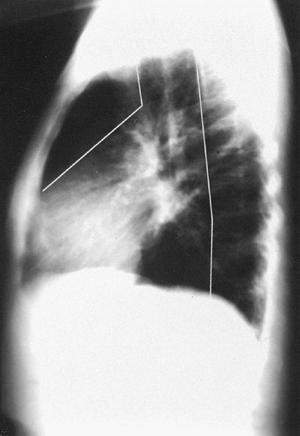 |
Fig. 158-1. Compartments of the mediastinum. Lateral radiograph contains two lines, one along the anterior tracheal air column extending along the anterosuperior aspect of the heart shadow and the second along the anterior aspect of the vertebral bodies. These lines divide the mediastinum into anterior, middle, and posterior compartments. |
In order to adequately interpret CT and MR images of the mediastinum, the reader will have to become familiar with cross-sectional anatomy. This is beyond the scope of this monograph but can be acquired in many textbooks on CT or MR imaging of the thorax or in textbooks on cross-sectional anatomy.
Anterior Mediastinal Masses
The masses of the anterior mediastinum primarily arise from the two organs that are present in this space: the thyroid (the majority of which arise initially in the neck) and the thymus. Rarely tumors of the parathyroid may also occur in the anterior mediastinum. Ahn and colleagues (1996) have noted that CT increases the accuracy of imaging diagnosis of anterior mediastinal masses. However, this accuracy remains relatively poor with a correct first-choice diagnosis in only 48% of cases. Rebner and co-workers (1987) found similar low accuracy for CT diagnosis.
Thyroid Masses
Many thyroid masses are incidentally detected on chest radiographs, CT, and MR imaging because they are common asymptomatic masses. Most thyroid masses are readily palpated, and in some instances it is most expedient to diagnose them directly with needle aspiration rather than with imaging. Some thyroid masses are occult on chest radiographs; however, many thyroid masses are evident as anterior mediastinal masses. The most sensitive and specific plain film manifestation of a thyroid mass is focal deviation of the trachea at the level of the clavicles. It is rare for nonthyroid tumors to deviate the trachea, although it is often seen with the rare large parathyroid cysts as reported by Shields and Immerman (1999) (see Chapter 197). Larger thyroid masses also produce widening of the superior mediastinum. In most cases the particular type of thyroid mass (e.g., adenoma, carcinoma, lymphoma, multinodular goiter) are not diagnosable on the basis of the chest radiograph alone. If the mass is large and has remained stable over years, it is most likely a multinodular goiter. When a specific diagnosis is necessary, needle aspiration is the test of choice.
When necessary, the imaging study of choice is often a radionuclide thyroid scan. This provides both structural and functional information regarding thyroid masses and may be the most specific imaging test of thyroid masses. Park and colleagues (1987) noted that thyroid scintigraphy was 93% sensitive and 100% specific for thyroid goiters, the most common thyroid tumor. Ultrasonography may be useful in demonstrating that a thyroid mass is a simple cyst and in guiding needle aspiration in patients with nonpalpable nodules. Simple cysts are seen in ultrasound imaging as sharply marginated, thin-walled, round or oval structures with no internal echoes and with through transmission of sound. In general, CT and MR imaging are not indicated for the evaluation of thyroid masses. However, they are useful in distinguishing between thyroid masses and other mediastinal masses. Glazer and associates (1982) were among the first to show that CT can readily demonstrate the contiguity of a mass with the thyroid gland and thereby indicate that the mass is of thyroid origin. These investigators, as well as von Schulthess and colleagues (1986), demonstrated distortion of the great vessels anteriorly and laterally, thereby confirming the correct placement of these masses anatomically (see Chapter 168).
The most common thyroid mass is the multinodular goiter. This is a benign tumor of the thyroid gland commonly seen in elderly patients. In all cross-sectional imaging it has similar features. It appears as a multilobular mass with multiple rounded nodular areas, and there are usually associated cysts and foci of calcification. These nodules and cysts may be of widely varying sizes.
Thyroid adenomas appear as discreet nodular masses within the substance of the thyroid. It is not possible to distinguish benign from malignant masses on the basis of imaging studies, and histologic or cytologic analysis of a solitary thyroid mass is necessary to determine whether it is malignant. A smooth, well-defined contour favors a benign adenoma, whereas an ill-defined infiltrating mass almost always represents a thyroid carcinoma.
Thymoma
The thymus normally appears as a bilobed V-shaped structure, often best visualized at the level of the aortic arch but frequently seen extending from the left brachiocephalic vein to the root of the aorta and pulmonary artery. Moore and colleagues (1983) reported that normal thymic measurements vary with age, with the thymus progressively decreasing in size as patients age. Fifty percent of patients over 50 years of age demonstrate complete fatty involution of the thymus, with glandular thymic tissue often absent in patients over 30 years of age. Residual thymic tissue is seen as a small collection of fat in the anterior mediastinum, occasionally mixed with thin soft tissue strands. Thymic hyperplasia results in enlargement of the thymic gland while maintaining a thymic configuration (Fig. 158-2).
In patients over 40, when the incidence of lymphomas is lower, the presence of an anterior mediastinal mass is suggestive of thymoma. Ellis and colleagues (1988) found that, in patients with myasthenia gravis, 42% of thymomas were radiographically occult. Therefore, patients with a clinical suspicion of thymoma should undergo CT or MR imaging.
A subtle opacity in the anterior clear space on the lateral chest radiograph is probably the most sensitive radiographic manifestation of small thymomas (Fig. 158-3). Larger masses
P.2372
appear as widening of the mediastinum on PA radiographs and fill the anterior clear space on the lateral radiograph. Thymomas may also appear as focal abnormalities of the mediastinal contour. Although most often thymomas appear in the anterior mediastinum just caudal to the aortic arch, thymic tissue and therefore thymomas may occur from the region of the thyroid gland to the cardiophrenic angles on either side of the heart.
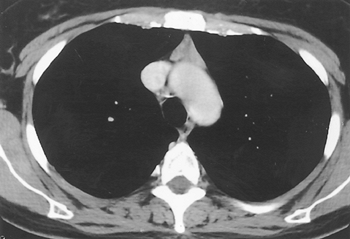 |
Fig. 158-2. Thymic hyperplasia. Computed tomography at the level of the aortic arch demonstrates anterior mediastinal soft tissue that has a thymic configuration. In this patient, thymic hyperplasia was secondary to thyrotoxicosis. |
On CT and MR images, small thymomas usually appear as a spherical or ovoid mass in the expected location of the thymus. Larger tumors may appear as large discrete anterior mediastinal masses or as soft tissue that infiltrates and insinuates around the major mediastinal organs. Verstandig and colleagues (1992) have demonstrated that tumors showing infiltration into adjacent fat are always invasive. However, it is impossible on the basis of imaging to determine whether well-circumscribed thymic tumors are completely encapsulated or have microscopic invasion.
Thymomas may metastasize to the lung or pleura. Pleural metastasis may appear as discrete masses, without pleural effusion. This is a characteristic feature of thymoma, which is rarely seen in other malignancies. Thymoma is seen in 10% to 15% of patients with myasthenia gravis. It is also associated with red cell aplasia, hypogammaglobulinemia, mucocutaneous candidiasis, and other autoimmune phenomena.
Lymphoma
The most common tumors of the anterior mediastinum and thymus are Hodgkin's and non-Hodgkin's lymphomas. Hodgkin's disease usually occurs in young adults but may be seen at nearly any age. Non-Hodgkin's lymphomas are more common in elderly individuals but may occur in young adults as well. Lymphomas may appear as isolated anterior mediastinal masses, may be associated with pulmonary parenchymal infiltrates, or may be associated with adenopathy in the mediastinum, neck, axilla, or abdomen (Fig. 158-4). Early lymphomatous involvement of the thymus may be occult on chest radiographs, but on cross-sectional imaging appears as a triangular-shaped mass, mimicking the shape of the normal thymus. As the mass becomes larger it becomes more rounded or amorphous in shape. Cavitation or cystic degeneration is rare. The tumor may grow directly into the lung or surrounding structures of the chest wall. This feature is characteristic of lymphomas and its presence makes a diagnosis of lymphoma more likely than other anterior mediastinal masses.
Lymphomas also commonly involve mediastinal, axillary, and supraclavicular lymph nodes and occasionally affect hilar lymph nodes. When large, these may be seen on chest radiographs. However, chest radiographs are insensitive to smaller but still enlarged mediastinal nodes that may be demonstrated by CT and MR imaging. Castellino and co-workers (1996) noted that thoracic CT detected disease that had been occult on chest radiographs in 9% of patients with newly diagnosed non-Hodgkin's lymphoma and detected increased extent of disease relative to chest radiographs in an additional 27%. Salonen and co-workers (1987) have reported that CT-detected mediastinal involvement of lymphoma is missed by chest radiography in 39% of cases. As a consequence, cross-sectional imaging is commonly used to monitor mediastinal disease progression during chemotherapy. In follow-up examinations, persistent, stable soft tissue in the anterior mediastinum indicates residual fibrosis without persistent tumor and does not require further therapy, a concept emphasized by Thomas and colleagues (1988) in their report of surveillance CT in the therapy of Hodgkin's lymphoma.
Lymphoma may also involve the posterior mediastinum. This most commonly appears as a mantle of soft tissue surrounding one or multiple vertebral bodies.
Germ Cell Tumors
Teratomas and other mediastinal germ cell tumors may be impossible to distinguish from thymomas by imaging criteria alone. Both can appear as discrete or infiltrating anterior mediastinal masses. On cross-sectional imaging both may appear as solid masses and may contain calcifications. Teratomas, however, more frequently than thymomas, show areas of low density within the mass because of either cystic or fatty components. In a study by Moeller and colleagues (1997), 63% of mature mediastinal teratomas contained solid, fluid, and fatty elements with or without associated areas of calcification. This combination of findings is virtually pathognomonic of a benign mature teratoma, the most common mediastinal germ cell tumor,
P.2373
accounting for 75% of all mediastinal germ cell tumors. Malignant germ cell tumors, such as seminoma, choriocarcinoma, and yolk sac tumors often have a less-specific, homogeneous soft tissue attenuation. Germ cell tumors more commonly occur in younger patients, an average of 24 years of age in the study by Moeller and colleagues (1997), whereas thymomas are most often seen in middle-aged or elderly patients.
Other Anterior Mediastinal Tumors
Thymic Carcinoids
Brown and associates (1982) reported CT to be helpful in localizing thymic carcinoid tumors in patients suspected of having ectopic production of adrenocorticotropic hormone, and Doppman and colleagues (1989) believe that a normal CT excludes the presence of a thymic carcinoid. These tumors characteristically appear as large lobulated soft tissue masses embedded within the substance of the thymus. Neuroendocrine tumors, such as thymic carcinoids, are characteristically very bright on T2-weighted images. The presence of this feature is highly suggestive of a neuroendocrine tumor.
Thymic cysts are benign tumors of the thymus, which most often present as an asymptomatic mass in the anterior mediastinum. Imaging demonstrates a smooth, round, or oval mass. Cross-sectional imaging demonstrates a thin or imperceptible wall with contents consistent with a cyst. On MR imaging the contents have an intermediate gray signal on T1-weighted sequences and a high, bright white signal on T2-weighted sequences. On CT imaging thymic cysts usually have an attenuation of 0 to 20 Hounsfield units (HU) and are nonenhancing. Unfortunately, some thymic cysts have an attenuation of greater than 20 HU and may therefore be confused with solid masses.
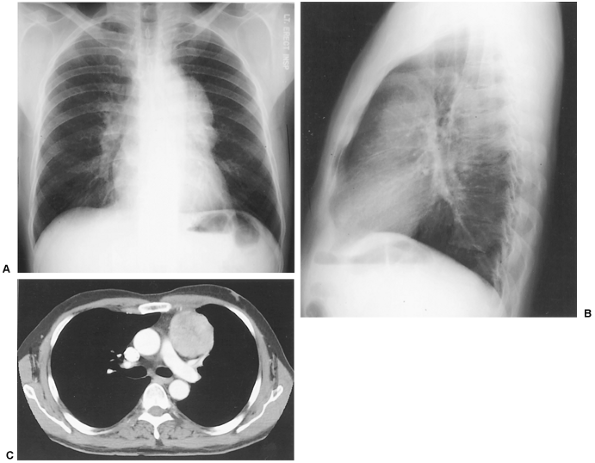 |
Fig. 158-3. Thymomas. A. Posteroanterior chest radiograph demonstrates an abnormal lobulated left mediastinal contour through which hilar anatomy is visualized. B. Lateral radiograph reveals a subtle mass in the anterior mediastinum. C. Computed tomography performed at the level of the main pulmonary artery confirms the presence of a mass in the anterior mediastinum, which was subsequently proven to represent a noninvasive spindle cell thymoma. |
Thymolipomas
Thymolipomas are rare tumors of the anterior mediastinum containing both thymic stroma and an abundance of
P.2374
fat (Fig. 158-5). They are usually large asymptomatic masses that appear as a smooth enlargement of the inferior anterior mediastinum on chest radiographs. Rosado-de-Christenson and co-workers (1994) have noted that these masses often simulate cardiomegaly on chest radiographs. CT and MR imaging is usually diagnostic of this tumor, showing a mixture of soft tissue and fat within the mass. The only significant differential diagnosis is a mediastinal teratoma.
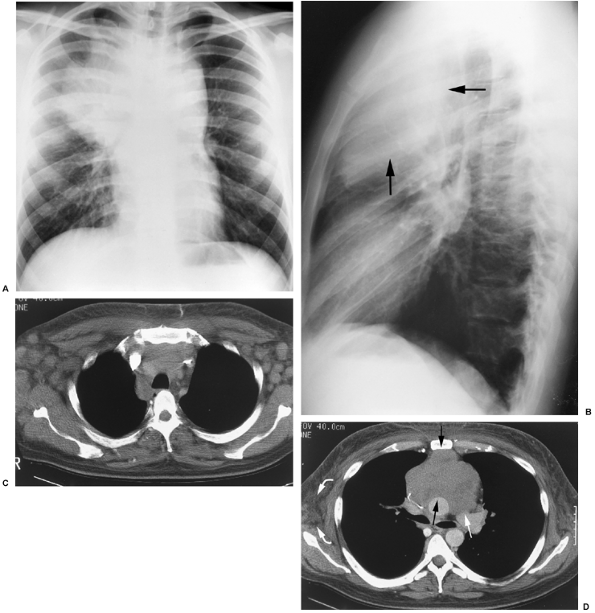 |
Fig. 158-4. Hodgkin's lymphoma. A. Posteroanterior chest radiograph demonstrates a large mediastinal mass. B. Lateral chest radiograph shows this mass to opacify the anterior clear space (arrows), indicating that it is an anterior mass. In this 25-year-old man, it is statistically most likely to represent a lymphoma. Computed tomographic images at the level of the axilla (C) and carina (D) confirm the presence of the large anterior mediastinal mass (straight arrows), but also reveal extensive axillary adenopathy (curved arrows). Supraclavicular lymph node biopsy indicated Hodgkin's lymphoma. |
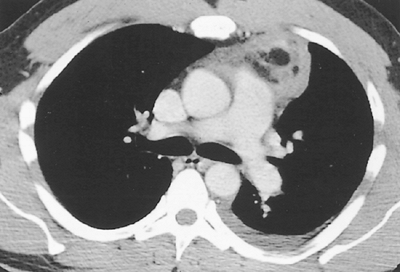 |
Fig. 158-5. Thymolipoma. Computed tomography at the level of the main pulmonary artery reveals an anterior mediastinal mass with a low-density component, representing fat (arrows). Pathology confirmed a thymolipoma. |
Parathyroid Tumors
Technetium 99m sestamibi scintigraphy is currently the most sensitive imaging procedure for parathyroid adenomas,
P.2375
which can be present anywhere from the base of the tongue to the surface of the pericardium; intrathymic location is common. Occasionally the sestamibi scintigraphy is performed as a subtraction image with iodine 123 scans. Hindie and colleagues (1997) have shown a 95% sensitivity of 99mTc-sestamibi scintigraphy for hyperfunctioning adenomas. MR imaging may also be useful to identify mediastinal parathyroid adenomas in patients with unexplained hypercalcemia. These usually appear as small (<3 cm), well-defined masses in the anterior mediastinum that are isointense to muscle on T1-weighted images and very hyperintense to muscle on T2-weighted images. Lee and co-workers (1996) have shown that in cases of occult parathyroid adenomas, the combination of both MR imaging and 99mTc-sestamibi scintigraphy often is more sensitive for the detection of adenomas than with either imaging study alone.
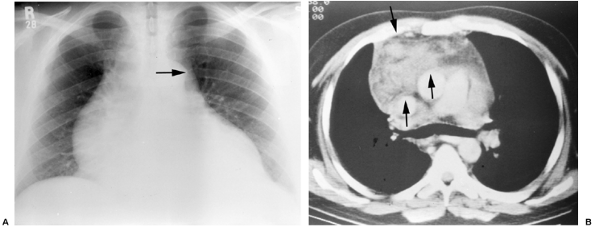 |
Fig. 158-6. Mediastinal lymphangioma. A. Posteroanterior chest radiograph reveals an abnormal right paratracheal contour (arrow). B. Computed tomographic image at the level of the great vessels demonstrates a mass consisting of fluid attenuation (arrows). A cystic hygroma was surgically excised. |
Cystic Hygromas
Lymphangiomas or cystic hygromas are rare benign tumors of the lymphatic system. They characteristically arise in the neck but can rarely be completely intrathoracic or have an intrathoracic component. Chest radiographs demonstrate a nonspecific anterior or middle mediastinal mass. On cross-sectional imaging they often appear as unilocular or multilocular cystic masses with a variable solid component and occasional areas of hemorrhage, as noted by Miyake and co-workers (1996) (Fig. 158-6). Although histologically benign, these tumors often infiltrate around the mediastinal organs, preventing complete surgical excision.
The Middle Mediastinum
Adenopathy
The chest radiograph is insensitive to the detection of mediastinal and hilar lymphadenopathy. Lymph nodes as large as 2 or 3 cm may be occult on chest radiographs. When present, lymphadenopathy may appear as nonspecific widening of the mediastinum, thickening of the right paratracheal stripe, filling in of the normal anteroposterior (AP) window concavity, or as subtle opacity in the subcarinal region (Fig. 158-7). Hilar adenopathy appears as an enlarged hilum on chest radiographs. The hilum often has a lumpy contour when adenopathy is present.
Perhaps the greatest utility of CT in evaluation of the mediastinum has been in the detection of lymphadenopathy.
P.2376
The extent and distribution of lymphadenopathy is accurately assessed with CT. Lymph nodes appear as discrete or confluent regions of soft tissue attenuation separable from other mediastinal structures, particularly when intravenous contrast has been administered (Fig. 158-8; see Figs. 158-4 and 158-7). Lymphadenopathy may contain regions of lower attenuation because of necrosis or high attenuation due to calcification from granulomatous disease, chemotherapy, or radiation therapy. The identification of lymph nodes does not indicate their histologic characteristics or even the presence of disease. Anatomic and pathologic studies reported by Genereux and Howie (1984) of patients with no known chest disease frequently identified lymphadenopathy in all regions of the mediastinum. Lymph node size tended to vary with location; however, 95% of normal lymph nodes were less than 11 mm in diameter. Enlarged lymph nodes may have a variety of causes, including metastatic tumor, lymphoma, sarcoidosis, and other granulomatous or inflammatory causes.
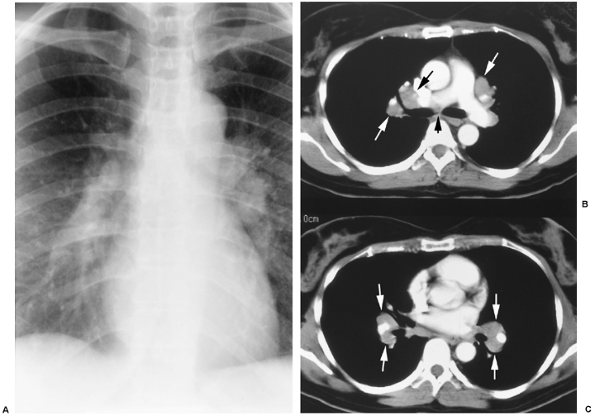 |
Fig. 158-7. Sarcoidosis. A. Posteroanterior chest radiograph demonstrates enlargement of the hila bilaterally. This may be secondary to either vascular enlargement or hilar adenopathy. B, C. Contrast-enhanced images through the lung hila demonstrate multiple nonenhancing masses characteristic of hilar adenopathy. Subcarinal adenopathy (arrows) is also present. This was secondary to sarcoidosis. |
Metastatic Adenopathy
Metastatic lung cancer is the most common cause of malignant adenopathy. A short axis dimension of 10 mm is used as the criterion for reporting potentially abnormal lymph nodes in lung cancer staging studies. It has become apparent that assessment of nodal size by CT is not sufficiently accurate for routine clinical staging, because significant numbers of small lymph nodes contain microscopic metastasis and some large lymph nodes are free of metastatic disease. Series by Whittlesey (1988) and McKenna and associates (1985) demonstrated a 25% to 30% chance for recovering metastases in lymph nodes measuring 11 to 19 mm and a similar chance for not revealing metastatic disease
P.2377
in nodes measuring greater than 20 mm. Nonneoplastic nodal enlargement may be a manifestation of inflammatory changes related to postobstructive pneumonia. For this reason, squamous cell carcinoma has the highest likelihood of being associated with benign nodal enlargement. Shimoyama and co-workers (1997) have suggested that morphology of hilar lymph nodes may help in separating benign from malignant lymph nodes. In their preliminary study of lung cancer patients, hilar lymph nodes with a convex margin to the lung parenchyma had an 87% sensitivity and 88% specificity for malignant adenopathy, regardless of node size. The reliability of this finding must be validated in future larger studies. Thus, at present CT is best used as a tool to guide surgical staging to the most likely sites of metastatic spread. In addition, some clinicians believe that the absence of radiographically detectable lymph nodes on a good quality CT scan obviates the need for staging mediastinoscopy prior to definitive surgical resection.
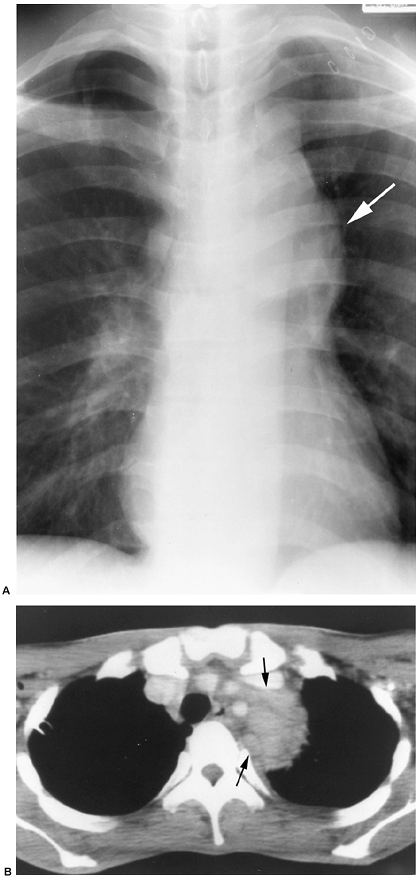 |
Fig. 158-8. Mycobacterial infection in a patient with acquired immunodeficiency syndrome. This patient complained of chest pain. A. Posteroanterior chest radiograph demonstrates a mass (arrow) obscuring the normally concave aortopulmonary window. B. Computed tomographic image at the level of the great vessels demonstrates a conglomerate mass of mediastinal lymph nodes (arrows). Cultures indicated Mycobacterium avium-intracellulare infection as the etiology. |
Positron emission tomographic (PET) scanning, with its ability to distinguish between metabolically active and quiescent tissues, may be the imaging test that in the future will noninvasively stage the mediastinum in lung cancer. However, false-positive and false-negative PET scan results may be encountered. Metabolically active inflammatory conditions will lead to false-positive imaging results.
Metastatic adenopathy from tumors other than lung cancer is uncommon. Renal, testicular, and breast carcinomas, as well as melanoma, are some of the extrathoracic malignancies more likely to develop malignant mediastinal adenopathy.
Lymphoma
Lymphoma is a common cause of mediastinal adenopathy. Thymic involvement with a large anterior mediastinal mass in the most common focus of thoracic lymphoma. However, involvement of mediastinal and hilar lymph nodes are common. (For more details on lymphoma, see the earlier subsection on Lymphoma under the section on Anterior Mediastinal Masses.)
Inflammatory Adenopathy
Mildly enlarged mediastinal nodes (short axis diameter of 10 to 20 mm) may be seen in a wide variety of inflammatory conditions of the thorax, including pneumonias, interstitial lung disease, and many other conditions. Therefore, in the setting of a known inflammatory process in the thorax, the clinician should remain unconcerned with the presence of a few mildly enlarged lymph nodes. For example, nodal enlargement is a consistent finding in other chronic infiltrative interstitial diseases, including scleroderma and usual interstitial pneumonitis. However, the presence of many mildly enlarged lymph nodes or the presence of markedly enlarged lymph nodes (>20 mm), should prompt an investigation for their cause.
P.2378
Sarcoidosis
Sarcoidosis is among the most common nonneoplastic cause of mediastinal and hilar lymphadenopathy. Sarcoidosis characteristically causes moderate to marked enlargement of bilateral hilar and right paratracheal lymph nodes (see Fig. 158-7). These are usually readily apparent on chest radiographs. Many patients have concurrent interstitial lung disease. (See Chapter 10 for more details regarding thoracic involvement with sarcoidosis.)
Mycobacterial Infections
Primary tuberculosis (TB) most commonly presents with a focal alveolar pneumonia and associated unilateral hilar or mediastinal adenopathy. Because most primary tuberculosis is unrecognized clinically, it is relatively uncommon to image primary tuberculosis in the United States. Adenopathy is rare in postprimary or reactivation TB and in nontuberculous infections in immunocompetent patients. However, in patients infected with human immunodeficiency virus (HIV), both tuberculous and nontuberculous mycobacterial infections commonly result in mediastinal and hilar adenopathy (see Fig. 158-8).
Fungal Infections and Sclerosing/Fibrosing Mediastinitis
Fungal infections such as histoplasmosis, coccidioidomycosis, and cryptococcosis may be associated with hilar or mediastinal lymphadenopathy. Lymphadenopathy may be unilateral or bilateral in extent and may be an isolated finding, or may be associated with parenchymal lung disease (see Chapter 10). Adenopathy with these disorders is particularly common in patients with HIV infection and is more likely to be an isolated finding in this population. The granulomatous fibrosis that is the residuum of these infections often calcifies as it ages, which is apparent as an increased density on chest radiographs or increased attenuation on CT scans.
Fibrosing or sclerosing mediastinitis is an uncommon chronic sequela of prior mediastinal involvement with granulomatous infections, usually prior histoplasmosis. A chronic, noninfectious inflammatory process secondary to activation of type IV delayed hypersensitivity response results in progressive mediastinal fibrosis. The fibrosis may constrict or obstruct virtually any of the mediastinal organs. This can result in atelectasis from bronchial constriction, superior vena cava (SVC) syndrome from SVC constriction, dysphagia from esophageal constriction, pulmonary venous congestion from pulmonary vein constriction, or pulmonary oligemia from pulmonary artery constriction (Fig. 158-9).
Chest radiographs may appear normal, demonstrate areas of pulmonary atelectasis, or show sheets of mediastinal calcification. CT scans demonstrate an ill-defined focal or diffuse mass infiltrating the mediastinum and constricting or obstructing one of the aforementioned mediastinal structures. In the majority of cases, and in six of seven cases reported by Weinstein and colleagues (1983), there is extensive calcification associated with the fibrotic mass. This appearance is virtually pathognomonic of this disorder. MR imaging is less useful in evaluating fibrosing mediastinitis because it is relatively insensitive to the presence of calcification, the primary clue to the imaging diagnosis of this disorder.
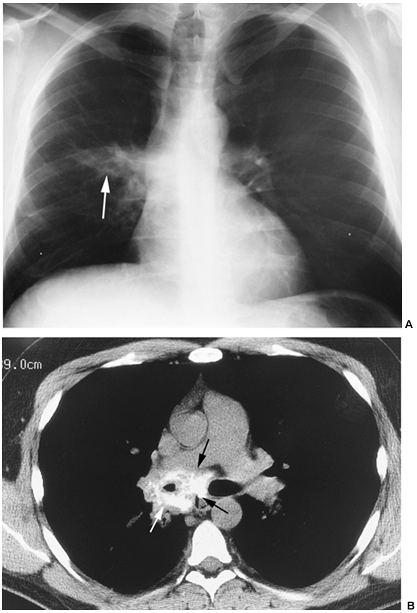 |
Fig. 158-9. Fibrosing mediastinitis. This man complained of vague chest pain. A. Chest radiograph demonstrates an ill-defined opacity in the right middle lung (arrow), originally thought to represent pneumonia. This did not clear radiographically; therefore, a computed tomographic scan was ordered to exclude an endobronchial lesion. B. Unenhanced computed tomographic scan at the level of the carina reveals an amorphous calcified mass (arrows), narrowing the right main stem bronchus. This appearance is essentially pathognomonic of fibrosing mediastinitis. |
Other Causes of Mediastinal Adenopathy
There are a wide variety of rare infectious and immunologic causes of diffuse lymphadenopathy, including
P.2379
Castleman's disease, angioimmunoblastic lymphadenopathy, catscratch disease, and Kikuchi's disease. There is usually nonspecific enlargement of lymph nodes on imaging examinations, and diagnosis depends on clinical criteria and pathologic analysis of resected nodes. A diagnosis of Castleman's disease may be suggested by the presence of intense nodal enhancement.
The Great Vessels
Abnormalities of the great vessels of the thorax may be occult on chest radiographs but when apparent are inferred by the location of mediastinal widening or mediastinal masses. A mass localized to the left middle mediastinum in the location of the descending aorta can indicate an aneurysm or chronic dissection. Aberrant subclavian arteries pass behind the trachea and may produce a focal indentation in the posterior aspect of the tracheal air column on the lateral view. The left superior intercostal vein is a collateral pathway for blood flow and may enlarge in response to chronic obstruction of the SVC. The enlarged vein appears as a small bump on the lateral surface of the contour of the aortic arch and is known as an aortic nipple. Cross-sectional imaging has revolutionized the evaluation of abnormalities of the great vessels of the thorax. Both CT and MR imaging directly visualize the vessels and can separate them from the other mediastinal organs. In general, MR imaging has some advantages in evaluating vascular disorders because it does not require intravenous contrast and has multiplanar capabilities. However, both CT and MR imaging are very accurate for the diagnosis of a variety of abnormalities of the mediastinal great vessels. Ho and Prince (1998) provide a detailed review of thoracic MR aortography, including imaging strategies for specific vascular abnormalities.
Aortic Dissection
Cigarroa (1993) and Sommer (1996) and their colleagues directly compared the accuracy of CT, MR imaging, and transesophageal echocardiography in the evaluation of aortic dissection. All three modalities are accurate in the diagnosis of this disorder, with accuracies between 90% and 100%. There is disagreement between Cigarroa (1993) and Sommer (1996) and their colleagues whether spiral CT or MR imaging is the most accurate study in the evaluation of aortic dissection. However, for practical purposes there is little difference between these modalities, and the choice of study is best made on the basis of local availability and expertise. Because of its portable nature, transesophageal echocardiography is the preferred examination in hemodynamically unstable patients.
All three cross-sectional imaging techniques diagnose this disorder by demonstrating the presence of an intimal flap separating a true and false lumen. Posniak and colleagues (1993) have noted that a motion artifact at the root of the aorta may cause false-positive diagnosis of aortic dissection. This characteristically is limited to two or three contiguous sections. Reconstruction of the images over a shortened scan period, usually 0.6 seconds rather than the usual 1.0 seconds, often removes the artifact. If necessary, reexamination with 2.0-second scanning may also indicate the artifactual nature of the finding. This pitfall is uncommonly encountered with more rapid imaging, including multidetector CT.
It is important to determine the extent of dissection. Dissections in hemodynamically stable patients that involve only the aorta distal to the left subclavian artery may be managed nonsurgically with antihypertensive medication. These are known as type B dissections by the Stanford classification system (Fig. 158-10). Type A dissections, those that involve the aorta proximal to the left subclavian artery, are virtually always managed surgically because of the risk for coronary or carotid artery occlusion and the risk for tamponade from hemopericardium. Cross-sectional imaging may demonstrate the extension of the dissection into the innominate, subclavian, or carotid arteries. It rarely shows pericardial effusion, indicating dissection into the pericardial space. MR imaging has the added advantage of being able to detect aortic regurgitation in patients in which the dissection has involved the aortic valve.
Imaging also provides satisfactory follow-up in patients with aortic dissection, treated either surgically or medically, including the development of aneurysms of the true or false lumens. Sebastia and colleagues (1999) systematically review the utility of helical CT in aortic dissection.
Aneurysm
Atherosclerosis is the most common cause of aortic aneurysm in developed countries. Other causes include mycotic aneurysms, syphilitic aortitis, and a variety of arteritides such as Takayasu's and giant cell arteritis. Arteries should have a progressively decreasing caliber as they progress from a central to a peripheral position. If a vessel caliber increases from central to peripheral, there is by definition an aneurysm, regardless of which vessel it is in or the absolute value of the diameter of the vessel. Much of the cross-sectional literature also maintains that if the aortic cross section exceeds a certain diameter, this is also diagnostic of aneurysm. The commonly sited values are 4.0 cm for the ascending aorta and 3.5 cm for the descending thoracic aorta. The clinician should be careful in applying these values since they are based on averages. A 4.1-cm aorta has a different meaning in a small woman and a large man and whether it involves a focal area of dilatation or is part of a diffusely prominent aorta.
On plain films, an aneurysm may appear as a nonspecific widening of the mediastinum, a focal mediastinal mass, or deviation of the aortic contour. Cross-sectional imaging can directly identify enlargement of the aorta. In addition, cross-sectional
P.2380
imaging often demonstrates crescentic areas of mural thrombus within a large aneurysm. Siegel and colleagues (1994) were the first to recognize that a high-attenuation crescent within the mural thrombus on unenhanced CT images is a sign of impending rupture and is a relative indication for emergent surgery (Fig. 158-11). Arita and colleagues (1997) have suggested that the high-attenuation crescent is an area of acute hemorrhage into the organized thrombus. This event is thought to alter the wall stresses, which ultimately lead to rupture of the weakened aortic wall. Halliday and Al-Kutoubi (1996) have noted that the absence of a definable aortic wall adjacent to the spine on CT imaging is also indicative of a contained leak of an aneurysm. They have called this the draped aorta sign. Pleural effusion, demonstrated either by chest radiographs or cross-sectional imaging, suggests the presence of at least a small rupture and indicates the need for immediate surgical repair.
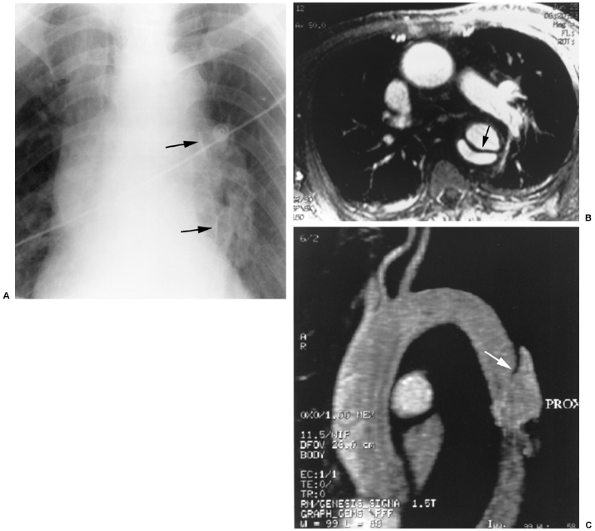 |
Fig. 158-10. Aortic dissection. This woman presented with acute chest and back pain. A. Chest radiograph reveals a curvilinear calcification (arrows) paralleling the left side of the mediastinum. This represents displacement of intimal calcification of the aortic wall. Although this is not 100% specific, it is highly suggestive of an aortic dissection. B. Gradient-echo, axial magnetic resonance images of the middle thorax demonstrate two lumina in the descending aorta, indicating an aortic dissection (arrow). C. Other axial images and this curved-planar reconstruction demonstrated the dissection to be confined to the descending aorta, a Stanford type B dissection. |
Imaging has an increasing role in the aneurysm patient following treatment, and especially after endovascular stent and graft placement (Fig. 158-12). Sakai and colleagues (1999) have demonstrated the utility of CT imaging in assessing stent patency and perigraft leaks.
Traumatic Aortic Rupture (Transection)
Traumatic aortic rupture or transection is a surgical emergency with a high mortality rate in the absence of surgical repair. This disorder is most commonly a result of
P.2381
blunt thoracic trauma such as from a motor vehicle accident or a fall from a height. It is believed that rapid deceleration results in sheering forces across the aortic wall, resulting in laceration of the intima and media. Frank extravasation is prevented by an intact adventitia. However, pressures result in focal dilation of the aorta at the site of injury, creating a pseudoaneurysm. Focal pseudoaneurysm and intimal flap are the aortographic hallmarks of transection.
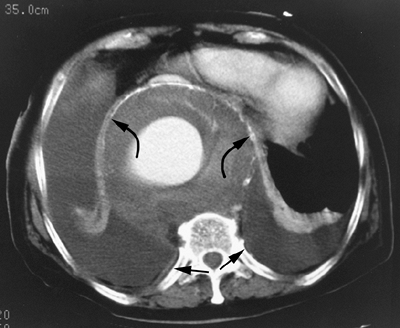 |
Fig. 158-11. Aortic aneurysm. Axial computed tomographic image through the thorax at the level of the diaphragms demonstrates a 12-cm aortic aneurysm. Note the high-density crescent within the mural thrombus (crescent sign; curved arrows), the absence of a defined aortic wall adjacent to the spine ( draped aorta sign), and the bilateral plural effusions (straight arrows). All three findings indicate imminent rupture or ongoing leakage of the aneurysm and are relative indications for emergent surgery. |
All trauma patients should undergo a chest radiograph as the first imaging study to evaluate for possible aortic transection. Findings suggestive of aortic transection include (a) irregular contour of the aortic arch, (b) lateral displacement of the paraspinal line, (c) filling in of the AP window, (d) left apical cap, (e) narrowing of the carina, (f) nasogastric tube displacement, and (g) nonspecific mediastinal widening. However, the greatest utility of the chest radiograph is in demonstrating a normal examination result. Mirvis and colleagues (1987) have shown that a normal erect chest radiograph has a 98% negative predictive value for the presence of aortic transection. Supine radiographs often demonstrate artifactual widening of the mediastinum. Therefore, it is important to obtain an erect radiograph or reverse Trendelenburg radiograph to reevaluate the mediastinum. If the chest radiographic result remains abnormal or if there is a high clinical suspicion of aortic injury, further imaging is necessary.
Aortography remains the standard examination for this disorder and in questionable cases remains the study of choice. However, many major trauma centers now accept high-quality spiral CT scanning as the primary diagnostic study for this disorder. A study by Gavant and co-workers (1995) indicated that spiral CT with 5-mm collimation and a rapid dynamic contrast injection (100 150 mL of contrast at 2 4 mL/s) has sensitivity approaching 100% and a specificity of 82% for aortic transection. Dyer and co-workers (1999) reported 100% sensitivity and 100% negative predictive value for the detection of traumatic aortic injury in a prospective study involving over 1,000 patients. CT imaging must demonstrate a pseudoaneurysm or intimal flap or both to make this diagnosis (Fig. 158-13). The presence of a mediastinal hematoma is a nonspecific finding, most often a result of mediastinal venous bleeding. Some physicians require further evaluation with aortography to exclude transection in a patient with mediastinal hematoma. However, many trauma surgeons and radiologists are now sufficiently confident of spiral CT that no further testing is performed if the CT scan demonstrates a normal aortic contour despite the presence of a mediastinal hematoma. Parker and co-workers (2001) emphasize the cost savings of using CT over aortography for the detection and exclusion of aortic injury. This decision must be based on a judgment of the quality of the CT scan and the clinical risk for aortic injury. In questionable cases, aortography should be performed. Creasy and colleagues (1997) have provided a useful review of imaging of traumatic injury to the thoracic aorta for those who wish to read more on this topic.
Congenital Anomalies of the Aorta
Congenital anomalies of the thoracic aorta are seen in a few percent of patients. Often these have little clinical significance, although they may be associated with congenital heart disorders and their presence may alter the surgical approach for esophageal surgery. A left aortic arch with an aberrant right subclavian artery is the most common congenital anomaly of the aorta. These abnormalities may be radiographically occult or evident as abnormalities of the aortic contour. For example, a left aortic arch or double aortic is apparent as an abnormal position of the aortic arch. However, even when apparent, the details of the anomalous vasculature are not evident.
Both CT scans and MR imaging are accurate in the diagnosis of congenital anomalies of the aorta (Fig. 158-14). They detail the relative positions of the normal and anomalous vessels. With its ability to image in multiple planes, MR imaging has a slight advantage over CT in diagnosing these complex disorders. Predey and colleagues (1989) have reviewed the CT appearances of congenital arch anomalies.
Abnormalities of the Great Veins of the Thorax
Abnormalities of the great veins of the thorax are relatively rare. The most common clinically significant abnormality is obstruction of the SVC, which can lead to swelling and erythema of the face and arms, known as SVC syndrome. At one time this was most commonly secondary
P.2382
to thoracic neoplasms, especially lung carcinoma. However, more recently, SVC syndrome is usually secondary to chronic indwelling central venous catheters, either by thrombotic obstruction or fibrotic stricture. The level of SVC obstruction may be readily demonstrated by either MR imaging or CT examinations. If the obstruction is chronic, dilation of collateral vessels may be detectable on chest radiographs. The azygos arch is seen as a focal opacity superior to the origin of the right main-stem bronchus. Distention of the azygos arch to greater than 10 mm on an upright chest radiograph is considered abnormal. Dilation of the superior intercostal vein may be seen as a tiny focal mass at the apex of the aortic arch. This is known as an aortic nipple.
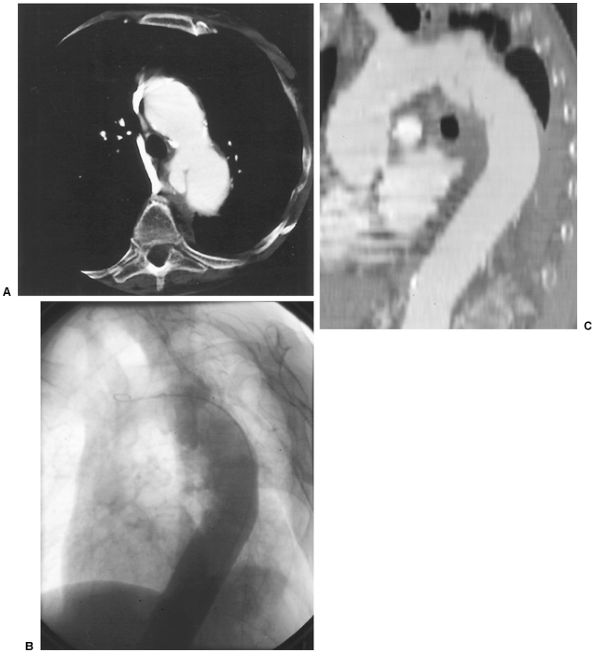 |
Fig. 158-12. Aortic pseudoaneurysm following aortic aneurysm repair with graft reconstruction. A. Axial computed tomographic image at the level of the aortic arch demonstrates a focal contrast collection medial to the proximal descending thoracic aorta. B. Oblique sagittal reconstruction of the aortic arch confirms the presence of a pseudoaneurysm along the inferior aortic arch. C. Aortic arch injection correlates with computed tomographic angiographic findings. |
Persistence of the left SVC is the most common congenital abnormality of the SVC. This may be seen as an anomalous position of central venous catheters, but is otherwise not detectable by chest radiographs. Anomalies of the great thoracic veins are usually easily demonstrated by either CT or MR imaging.
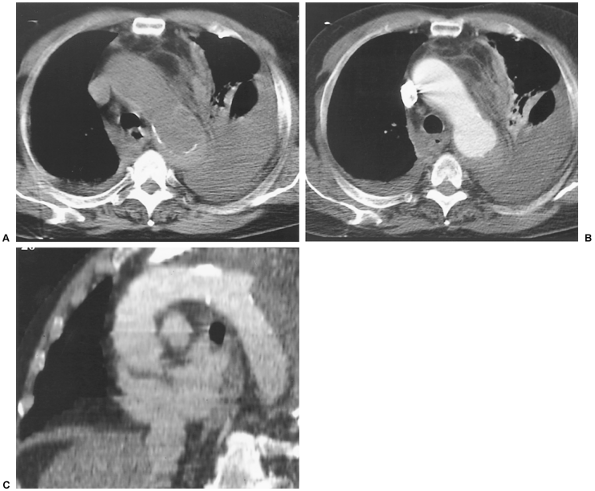 |
Fig. 158-13. Aortic rupture. A. Unenhanced computed tomography at the level of the aortic arch demonstrates a high-density crescent posterior to the contour of the proximal descending aorta. There is infiltration of the mediastinal fat. B. Enhanced computed tomography at the same level demonstrates a contour abnormality of the aorta, suspicious for aortic transection. C. Oblique sagittal reconstruction confirms the presence of a pseudoaneurysm along the superior margin of the aortic arch. The patient died while being prepared for emergent surgery. |
P.2383
Tracheal Diseases
Chest radiographic detection of tracheal diseases is an often difficult task. Radiographic findings can be subtle and readily missed if routine inspection of the tracheal air column is not performed. Polypoid masses within the tracheal air column usually indicate a neoplasm. Smooth tapered narrowing most often is postinflammatory or iatrogenic (Fig. 158-15). Occasionally, the presence of a tracheal mass can be inferred from the apparent absence of the tracheal air column on the chest radiograph (Fig. 158-16A).
The trachea and proximal bronchi are well evaluated by bronchoscopy, which has the added advantage over imaging of being able to provide tissue for histologic evaluation. However, bronchoscopy has difficulty in providing information on the extent of tracheal and central bronchial diseases, which is the forte of cross-sectional imaging in evaluating these structures.
Narrowing of the central airways may result in dyspnea, recurrent pneumonias, and other clinical problems. Strictures may be iatrogenic (following intubation, radiation therapy, or surgical anastomosis), postinflammatory (following mycobacterial, fungal, or bacterial infection), or neoplastic. The airways may be extrinsically narrowed by large mediastinal masses or constricted by mediastinal fibrosis, such as fibrosing mediastinitis. The appearance of nonneoplastic tracheal wall lesions at CT is reviewed by Webb and colleagues (2000). Whatever the cause, cross-sectional imaging can provide details of the cause and length of the stricture. This can be essential in preoperative planning when therapeutic stent placement is warranted in the care of airway strictures.
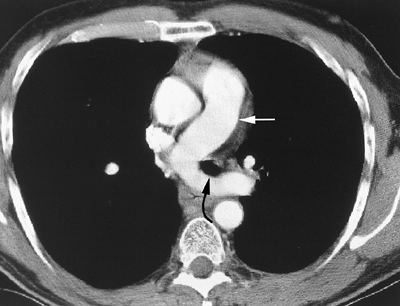 |
Fig. 158-14. Pulmonary sling. Enhanced computed tomographic image shows the left pulmonary artery (straight arrows) originating to the right of the trachea (curved arrow) and returning leftward between the trachea and esophagus. This vascular anomaly is known as a pulmonary sling. |
P.2384
It is often helpful to perform CT scans with a small field of view, targeted to the area of the trachea and main bronchi with a small effective slice thickness such as 3 mm collimation with a pitch of 1 to 1.8. This improves both axial and z-axis spatial resolution and improves the quality of nonaxial and three-dimensional reconstructions, which may be important in the preoperative evaluation of stent placement.
Fistulae from the lung or esophagus may result from neoplastic invasion and necrosis, or may result from chronic mycobacterial or fungal infections. Bronchoscopy and esophagoscopy often are more sensitive for the detection of subtle fistulae. Cross-sectional imaging details the extent of the inflammatory or neoplastic process, which can help in surgical planning.
Boiselle and associates (2002) reviewed the advantages of multidetector CT in the assessment of airway diseases, including multiplanar and three-dimensional imaging.
Diseases of Wall Integrity
Tracheomalacia is a descriptive term implying disorganization or destruction of the normal structures of the trachea. Most important is the integrity of the tracheal cartilages. Chronic inflammation or mechanical trauma such as that caused by endotracheal tubes can destroy the cartilaginous support of the trachea, resulting in fibrotic stenosis or a flaccid airway leading to fixed or dynamic collapse of the trachea (see Fig. 158-15). Aquino and associates (2001) have reported that CT imaging performed in expiration can assist in the diagnosis of acquired tracheomalacia. Patients with tracheomalacia have a significantly reduced sagittal diameter in expiration compared with inspiration and with normal patients.
Tracheomegaly (Mournier-Kuhns disease) is a rare idiopathic dilatation of central airways. Patients with this disorder are most commonly men 40 to 60 years of age. They may be symptomatic or present with recurrent respiratory tract infections. Imaging demonstrates marked enlargement of the trachea and central bronchi, with normal peripheral airways.
Tracheopathia osteochondroplastica is a rare idiopathic disorder resulting in osteocartilagenous growths adjacent to the cartilaginous rings of the central airways. Chest radiographs may show diffuse narrowing of the central airways. CT demonstrates nodular thickening of the tracheal and central bronchial walls with areas of coarse calcification. The membranous portion of the trachea is spared, a feature that helps distinguish this disorder from amyloidosis.
Relapsing polychondritis is a rare autoimmune connective tissue disorder of cartilage. Recurrent inflammation of the cartilaginous structures of the nose, ears, airways, and joints can lead to ear and nose deformities, joint pains, and airway narrowing. CT scans demonstrate diffuse narrowing of the airway and thickening, without calcification, of the airway walls.
Tracheal involvement with systemic amyloidosis is uncommon. When it occurs it usually results in diffuse or multifocal submucosal infiltrates. On CT scans, this appears as irregular thickening, with or without calcification, of the airway walls. Occasionally, amyloidosis may result in a single masslike lesion that may be confused with a neoplasm.
Table 158-1 reviews the manifestations and differential diagnosis of the diseases of tracheal wall integrity.
Tumors
Tumors of the trachea are rare but are most commonly carcinomas of the squamous epithelium of the trachea or tumors of the minor salivary glands such as adenoid cystic or mucoepidermoid carcinomas. Occasionally, papillomas, tumors caused by infection with human papilloma virus, or tumors of the connective tissue elements of the trachea and main bronchi such as chondromas or hamartomas are encountered. Both CT and MR imaging detail the precise location and macroscopic extent of theses tumors and provide information regarding regional lymphadenopathy. Care must be taken in evaluating adenoid cystic carcinomas (Fig. 158-16D). These tumors characteristically spread microscopically along the submucosal structures of the airways. As a consequence, CT and MR imaging may underestimate the longitudinal spread of tumor along the airway. Therefore, wide surgical margins beyond the macroscopic extent of tumor are necessary for adequate resection of this tumor.
Congenital Anomalies
These abnormalities are often associated with mediastinal vascular anomalies such as a pulmonary sling or
P.2385
P.2386
aberrant subclavian artery. The most common anomaly is the direct connection of a right upper lobe bronchus with the trachea, sometimes referred to as a pig bronchus. Some syndromes such as polysplenia and asplenia may by associated with abnormal airway anatomy. In polysplenia, the right lung usually has an airway distribution and lobar division mirroring a normal left lung; in asplenia, the left lung usually has an airway distribution and lobar division mirroring a normal right lung.
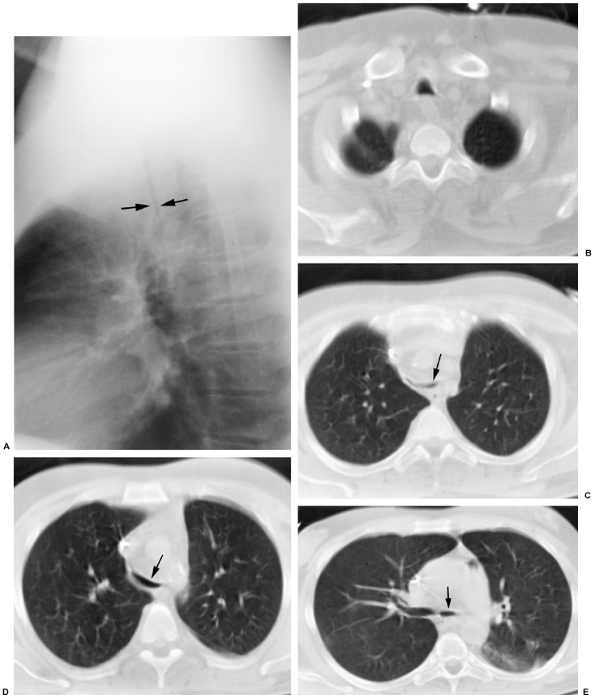 |
Fig. 158-15. Tracheomalacia. A. Lateral radiograph demonstrates a markedly narrowed trachea (arrows). (For comparison review the trachea in Figure 158-3B.) B E. Axial computed tomographic images from the clavicles to the carina demonstrate marked flattening of the trachea (arrows) without thickening of the wall. This flacid-appearing airway is indicative of tracheomalacia, with destruction of the normally rigid cartilaginous rings. This was treated with an airway stent. |
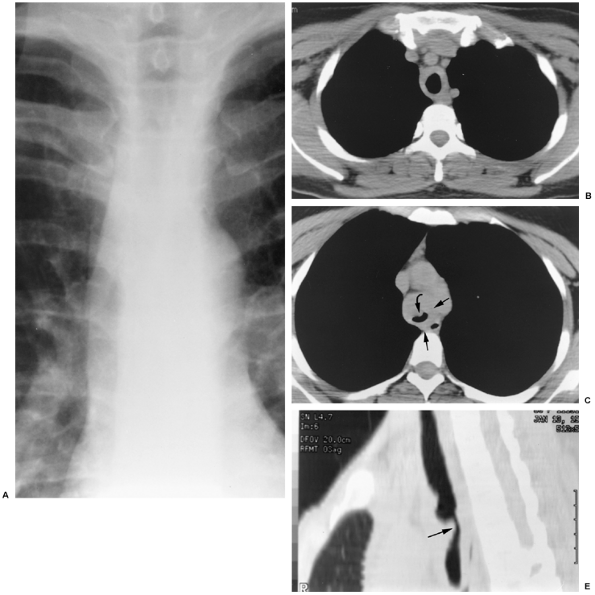 |
Fig. 158-16. Adenoid cystic carcinoma of the trachea. This patient complained of wheezing and increasing dyspnea over 6 months. A. Magnified view of the mediastinum on a posteroanterior chest radiograph shows the tracheal air column to be indistinct in the midportion. Axial images at the level of the great vessels (B) and the aortic arch (C) demonstrate circumferential thickening (straight arrows) of the tracheal wall with a focal mass (curved arrow) along the anterior surface of the trachea. D. Sagittal reconstruction of the computed tomographic images demonstrate severe stenosis at the level of the mass (arrow). The presence of a mass lesion is most often indicative of a neoplasm, in this case, an adenoid cystic carcinoma. The longitudinal spread of the tumor along the wall of the trachea is characteristic of this tumor. |
Bronchopulmonary Foregut Malformations
The trachea and esophagus embryologically originate as a common epithelial tube. Rarely, a portion of this embryologic
P.2387
structure can become isolated from the rest and result in a congenital epithelial cyst. When the lining of the cyst is ciliated columnar epithelium it is referred to as a bronchogenic cyst, and when the lining is composed of squamous epithelium it is referred to as an esophageal duplication cyst (Fig. 158-17). These may occur anywhere in the mediastinum or lung parenchyma and may communicate with the esophagus or trachea. Most commonly, bronchogenic cysts occur near the carina and esophageal duplication cysts occur near the gastroesophageal junction. Neuroenteric cysts are a rare form of bronchopulmonary foregut malformation in which the mediastinal cyst communicates with the thecal sac of the spinal canal. They are often associated with anomalies of the thoracic vertebra and thoracic spinal cord.
Table 158-1. Diffuse Disorders of the Tracheal Wall | |||||||||||||||||||||||||||||||||||
|---|---|---|---|---|---|---|---|---|---|---|---|---|---|---|---|---|---|---|---|---|---|---|---|---|---|---|---|---|---|---|---|---|---|---|---|
| |||||||||||||||||||||||||||||||||||
Bronchopulmonary foregut malformations may be occult on chest radiographs or may appear as nonspecific middle mediastinal masses or occasionally as intrapulmonary masses. These anomalies are readily demonstrated by both CT and MR imaging. The cyst should be smooth bordered with uniform attenuation on CT or signal intensity on MR imaging. Rim enhancement may be present following contrast administration, but the interior of the mass, being composed of fluid, should not enhance. Unlike most other simple cystic lesions of the body, bronchogenic cysts may not have attenuation between 0 and 20 HU. Nakata and associates (1982) in a study of seven bronchogenic cysts demonstrated attenuations ranging from 3 HU to 97 HU. These higher-attenuation cysts may be confused with solid masses. On MR imaging the contents of the cyst should show the usual characteristics of simple fluid: intermediate gray on T1-weighted sequences and uniformly bright on T2-weighted sequences. Therefore, if there is a clinical question regarding the cystic nature of a mediastinal mass, MR imaging may be useful.
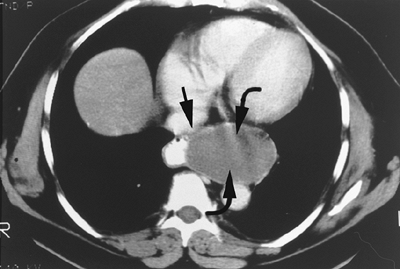 |
Fig. 158-17. Esophageal duplication cyst. Chest radiograph (not shown) in this patient demonstrated a subtle retrocardiac mass. Enhanced computed tomographic image demonstrates a fluid-filled mass (straight arrows), with an enhancing rim, adjacent to the left wall of the esophagus (curved arrows). This is characteristic of an esophageal duplication cyst. |
Esophageal Diseases
Most esophageal diseases are not detectable by chest radiographs. Further imaging with barium swallow or CT or MR imaging is necessary to detect abnormalities. One notable exception is achalasia, which appears as a large tubular mass of the middle mediastinum. Usually an air fluid level is present and is a clue to the diagnosis.
CT for esophageal disease should include administration of oral contrast in the minutes prior to the examination. This is not a normal feature of most chest CT examinations and therefore is often inadvertently omitted. A special request for oral contrast by the ordering physician ensures an optimal examination. Oral contrast is especially important when an esophageal fistula is expected.
On cross-sectional imaging the esophagus often appears as a flattened oval. Occasionally air or oral contrast demarcates the esophageal lumen. The wall of the esophagus is usually no more than 2 to 3 mm thick. Focal thickening most often indicates esophageal carcinoma, whereas diffuse thickening usually indicates esophagitis.
Characterization of mucosal diseases and carcinoma of the esophagus with imaging is best done with a barium swallow. However, demonstration of submucosal extent of disease, characterization of regional adenopathy and
P.2388
metastatic disease is an important role of cross-sectional imaging, usually CT scanning. Noh and colleagues (1995) have recently reviewed the CT manifestations of esophageal diseases.
Esophageal Carcinoma and Other Esophageal Neoplasms
Most esophageal carcinomas are not detectable by chest radiography. On cross-sectional imaging esophageal carcinoma appears as a focal circumferential enlargement of the esophagus. When obstructing, the proximal esophagus often is dilated with fluid and air (Fig. 158-18). All cross-sectional imaging performed in the evaluation of esophageal carcinoma should include imaging of the celiac axis, which is a common lymphatic drainage for distal esophageal carcinomas. CT may demonstrate enlarged mediastinal or upper abdominal lymph nodes, which suggest metastatic adenopathy. However, cross-sectional imaging is known to understage most esophageal malignancies. Hematogenous metastasis to lung or liver may also be detected. Maerz and associates (1993) have noted that CT is useful in identifying advanced disease and predicting resectability.
Tumors of the esophageal wall, such as leiomyoma and leiomyosarcoma usually do not affect the integrity of the esophageal lumen, and therefore they may attain a size such that they are detectable on chest radiographs. They usually appear as a nonspecific middle mediastinal mass in a location contiguous with the esophagus. Cross-sectional imaging shows these masses to be eccentric, relative to the lumen of the esophagus. They often are smooth and spherical compared with the irregular shape of most esophageal carcinomas. Occasionally they may cavitate or develop areas of dystrophic calcification.
 |
Fig. 158-18. Esophageal carcinoma. A. Axial computed tomographic image demonstrates an abnormal air fluid level in the proximal thoracic aorta. B. Computed tomographic image immediately inferior demonstrates marked concentric thickening of the esophageal wall (arrows) with narrowing of the lumen. The patient was diagnosed with an esophageal carcinoma. |
Esophagitis
Esophagitis is best characterized by barium swallow, which can often suggest the specific etiology. However, CT and MR imaging may occasionally reveal esophagitis while investigating other clinical questions. Most often, esophagitis appears as diffuse thickening of the esophageal wall. There is often periesophageal inflammation, which on CT appears as water attenuation density lines dirtying the normal uniform low attenuation of periesophageal fat. The target sign high-attenuation mucosa, low-attenuation submucosa, high-attenuation serosa is a common CT manifestation of inflammation of the bowel on enhanced CT scans. Berkovich and colleagues (2000) have shown that this sign may occasionally be present in esophagitis in addition to the more common finding of diffuse wall thickening.
Tracheoesophageal Fistula and Esophageal Perforation
Some of the more common causes of tracheoesophageal fistula include tumor invasion from the trachea or esophagus into the opposing structure, following radiation therapy for mediastinal malignancies, following tuberculous or other granulomatous infection, or following penetrating trauma. Endoscopy, bronchoscopy, and barium swallow are the studies of choice for evaluating this problem. CT or MR imaging may show the fistula if it is air or contrast filled. However, in some instances cross-sectional imaging merely shows soft tissue linking the two structures, without directly demonstrating the fistulous tract.
Esophageal perforation may be secondary to neoplasm, trauma, medical intervention such as endoscopy, Boerhaave's syndrome, or Boerhaave's equivalent. Chest radiographic findings are most often nonspecific, including
P.2389
pleural effusions and widening of the mediastinum. Rarely, collections of extraluminal gas are apparent. CT findings suggesting esophageal perforation include extraluminal air or fluid collections in the majority of patients, as in the 11 of 12 patients reviewed by White and associates (1993). Direct visualization of the perforation was rare, seen in only 2 of the 12 patients. Therefore, definitive diagnosis of esophageal perforation is usually dependent on barium swallow examinations or endoscopy.
Cardiac Diseases
Echocardiography, coronary angiography, and cardiac scintigraphy remain the primary means of noninvasively evaluating cardiac anatomy. MR imaging has become an important adjunct in the evaluation of complex congenital heart anomalies and is the study of choice in the evaluation of cardiac tumors. Electron beam CT has recently become an accepted tool for risk stratification for coronary heart disease of asymptomatic individuals. Preliminary data suggest that quantification of coronary artery calcium (scoring) by multidetector CT is of similar value. Multidetector spiral CT is currently under investigation regarding its ability to evaluate cardiac disease. The high spatial resolution and increased speed of scanning of this form of CT suggests that this may be an important tool for evaluating cardiac disease in the future.
Congenital Heart Disease
The evaluation of anatomic abnormalities associated with congenital heart disease can be among the most complicated tasks of thoracic imaging. Traditionally, a combination of echocardiography and cardiac catheterization has been used to elucidate the anomalous vascular connections in congenital heart disease. However, cardiac catheterization is an invasive procedure with significant risks to the patient. Echocardiography suffers from limited fields of view because of the acoustic shadowing associated with ribs and aerated lung. MR imaging has revolutionized the evaluation of congenital heart lesions and in many cases is the study of choice. T1-weighted images with respiratory compensation and electrocardiographic gating in various planes usually provide excellent delineation of the anatomic relationships between the cardiac chambers and the great vessels of the mediastinum. Occasionally, flow-sensitive gradient echo images also provide important anatomic information. Choe and co-workers (1997) reviewed the indications for MR imaging in congenital heart disease and have suggested that the applications include anomalies of right ventricular outflow obstruction, anomalies of pulmonary venous connections, anomalies of the aorta and truncal septation, anomalies of ventriculoarterial connections, ventricular morphology, and atrioventricular connections, among others. Haramati and colleagues (2002) examined the utility of MR imaging and CT in the surgical planning of patients with congenital heart disease.
Ischemic Heart Disease
Ischemic heart disease is primarily evaluated by coronary angiography and nuclear scintigraphy. However, recently electron beam CT has been accepted as a means of detecting subclinical coronary atherosclerosis. Before discussing the use of CT for coronary risk stratification, it is important to provide some background into the technical aspects of electron beam CT (EBCT). This form of CT is a unique engineering concept in which there are no moving parts. The electron beam, which creates the x-ray beam, is directed by a series of electromagnets toward a series of x-ray targets in the circumference of the CT scanner. With no moving parts, the speed of the scanner increases approximately 100-fold. Thus, a CT slice can be created in as little as 10 ms. Similar imaging parameters are now attainable by multidetector CT. This is sufficiently fast that there is no significant cardiac motion if the image is timed to occur during diastole.
With the ability to freeze cardiac motion, it is now possible to evaluate the coronary vessels. Electron-beam CT coronary angiography is currently an investigational tool but may be clinically useful in the future. EBCT has current clinical application in the quantification of coronary calcification. Researchers have known for a long time that coronary plaque calcifies over time, but until EBCT we have been unable to adequately quantify the extent of calcification to provide a reliable measure of coronary plaque. EBCT provides a total coronary calcification score, which is a mathematical construct based on the total area of coronary calcification and the attenuation of the calcification. When controlled for age and sex, this calcification score is a good predictor of the coronary risk for an individual.
Additionally, a variety of MR imaging techniques have been developed to evaluate ischemic heart disease. These include flow-sensitive pulse sequences to detect ischemic myocardium and tissue-tagging sequences to measure myocardial wall motion and wall stress. These remain investigational tools.
Valvular Heart Disease
Echocardiography remains the most reliable, noninvasive, easily accessible means of evaluating valvular heart disease. MR imaging, particularly with flow-sensitive pulse sequences such as gradient echo sequences, can demonstrate valvular stenosis and insufficiency. However, because of the greater expense of MR imaging and the lesser availability, MR imaging is not routinely indicated for the evaluation of valvular heart disease.
P.2390
Tumors
Cardiac and pericardial tumors are an uncommon occurrence. With the possible exception of atrial myxomas, which are well evaluated by echocardiography, MR imaging is the study of choice for cardiac and pericardial neoplasms. MR imaging provides the most comprehensive evaluation of tumor composition and its relationship to surrounding structures. Relationships to the myocardium, pericardium, pulmonary veins, and pulmonary arteries are readily demonstrated by high-quality MR imaging examinations. CT also provides excellent delineation of the anatomic relationships of a cardiac mass with the other mediastinal structures.
Among the most common cardiac tumors are pericardial cysts. Chest radiographs most often demonstrate a smoothly marginated mediastinal mass filling the medial costophrenic angle. However, any mediastinal mass adjacent to the heart silhouette may be a pericardial cyst. The most common differential diagnosis is a prominent paracardiac fat pad, but thymomas and mediastinal germ cell tumors may also occur in this location. CT and MR imaging demonstrate a well-defined, nonenhancing, round or oval mass with a thin or imperceptible wall adjacent to the myocardium. On CT this mass usually has an attenuation of 0 to 20 HU. MR imaging demonstrates signal intensities characteristic of a cyst: intermediate gray on T1 and bright white on T2 images.
Other cardiac neoplasms include lymphangiomas, hemangiomas, mesotheliomas, rhabdosarcomas, and angiosarcomas.
Posterior (Paravertebral Sulcus) Mediastinal Masses
The posterior mediastinum is defined as the mediastinum posterior to the anterior longitudinal ligament of the thoracic spine. The only major structures in this region of the mediastinum are the thoracic spine, spinal cord, and accompanying nerves. Lymphatic tissue and posterior lymph nodes are also present. However, masses of the posterior mediastinum are usually neurogenic tumors or tumors of bone. As with most mediastinal masses, the specific cause of a posterior mediastinal mass on a chest radiograph may be difficult to ascertain, but is often evident on cross-sectional imaging.
Neurogenic Tumors
Schwannoma is the most common posterior mediastinal neurogenic tumor. This benign tumor of the nerve sheath characteristically appears as a well-marginated round or oval mass adjacent to the thoracic vertebral body (Fig. 158-19). These may erode the surface of the adjacent ribs or enlarge the neural foramina but usually do not invade or destroy adjacent structures. Although, an enlarged neural foramina is only occasionally seen on standard radiographic studies, it should be noted that erosion of the neural foramina and extension of the neurogenic tumor into the spinal canal may occur in as many as 10% of patients with these nerve sheath tumors arising in the paravertebral sulcus. Other mesenchymal tumors and vascular lesions in this location may do so as well. Unfortunately, according to Akwari and associates (1978) 30% to 40% of these patients are asymptomatic at the time of diagnosis so that identification of such intraspinal canal extension must be made prior to any planned surgical procedure. This is best done by CT scan of the area in question. If the tumor is found to have extended into the canal, myelography or MR imaging should be performed to determine the longitudinal extent of the tumor within the canal. The presence of multiple posterior mediastinal masses suggests the diagnosis of neurofibromatosis with multiple neurofibromas. Malignant neural tumors are rare in adults. The most common malignant neural tumor of the thorax is the neuroblastoma, which characteristically occurs in infancy and presents as a large amorphous posterior mediastinal mass.
Disorders of the Thoracic Vertebra
Metastasis is the most common malignancy of the thoracic spine. Osteolytic metastasis appears as discrete oval defects in the vertebrae, usually the vertebral body. Rarely, metastasis appears as areas of increased bone density, or osteoblastic metastasis. Prostate cancer is the most common tumor to produce blastic metastasis. Primary malignancies of the thoracic spine are exceedingly rare, Ewing's sarcoma being the most common. There may be a variety of specific features of primary bone tumors but in general they appear as an infiltrating mass with its epicenter within the spine or ribs (Fig. 158-20). Lymphoma rarely involves the posterior mediastinum. When it does, it often appears as a mantle of soft tissue partially encasing the vertebral body.
Spinal osteomyelitis is an uncommon occurrence and may be due to a variety of pathogens, including bacteria, tuberculosis, and endemic fungi such as cryptococcosis and coccidioidomycosis. Bacterial osteomyelitis may be due to direct extension from a skin wound or as a result of hematogenous dissemination from a distant focus. It usually presents as acute onset of fevers and back pain. Because spinal osteomyelitis usually begins as infection of the intervertebral disc, chest radiographs usually demonstrate destruction of adjacent vertebral endplates with narrowing of the intervening intervertebral disc. There may be adjacent thickening of the paraspinal soft tissues. This is often more prominent with more chronic infections such as tuberculous or fungal osteomyelitis (Fig. 158-21). CT and MR imaging often demonstrate these abnormalities to greater advantage. Bony destruction is variable and depends on the duration of the infection. Tuberculous and fungal osteomyelitis are more indolent infections with insidious onset. Characteristically,
P.2391
the infection spreads over several vertebral levels and often demonstrates large paraspinal fluid collections when scanned by CT or MR imaging. There may be destruction of multiple vertebral bodies, especially the anterior surfaces, and the infection may result in a characteristic sharp angle scoliosis often referred to as a gibbus deformity.
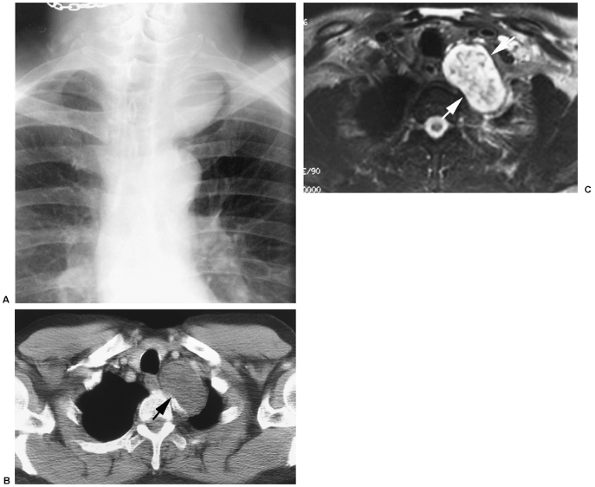 |
Fig. 158-19. Schwannoma. A. Magnified views of a posteroanterior chest radiograph demonstrate a smooth marginated apical mass. When a mass projects above the clavicles on a chest radiograph, it is virtually always a posterior mediastinal mass, usually a neurogenic tumor. B. Enhanced axial computed tomography confirms the presence of a mass (arrow). Attenuation of the mass averaged 14 Hounsfield units and was mistaken for a mediastinal cyst. C. T2-weighted axial magnetic resonance image shows a high-intensity irregular solid mass (arrows) characteristic of a neurogenic tumor. This proved to be a schwannoma rich in lipid. This lipid lowered the attenuation, causing the erroneous interpretation as a mediastinal cyst. |
Extramedullary hematopoiesis is an exceedingly rare cause of a posterior mediastinal mass. This disorder is due to recruitment of nonmarrow soft tissues in the production of blood cells in patients with severe anemias, most often thalassemia. Radiographically this appears as bilateral paraspinal soft tissue masses.
A chordoma is a rare paravertebral tumor in the thorax. Vertebral body destruction is uncommon with these tumors. A rare chordoma presenting as a bilobed paravertebral mass was recently described by Selvaraj and Wood (2003). The CT finding was helpful in revealing the extent of the tumor.
Disorders of the Hilum
The pulmonary hilum is composed of the central pulmonary arteries and veins and small peribronchial lymph nodes. Enlargement of these structures results in a contour abnormality of the hilum on the chest radiograph. Vascular abnormalities usually appear as tubular, branching enlargement of the hilum. Hilar adenopathy more often appears as nodular or lumpy enlargement of the hilum. Although, it is often possible to distinguish vascular enlargement from adenopathy based on the hilar morphology, in many instances cross-sectional imaging is necessary to adequately identify the cause of hilar enlargement.
In evaluating the hilum by CT scanning, it is essential to administer intravenous contrast. The hilar anatomy is sufficiently complicated that it is difficult to distinguish enlarged hilar vessels from hilar adenopathy without intravenous
P.2392
contrast. MR imaging does not suffer from this limitation because of the natural contrast between flowing blood and soft tissue inherent in most MR imaging pulse sequences. However, in general, MR imaging poorly evaluates the pulmonary parenchyma, which may be a contraindication to the use of MR imaging, depending on the cause of the hilar abnormality. Most often hilar abnormalities are related to pulmonary hypertension or adenopathy. Rarely bronchogenic cysts present in a hilar location. These can be distinguished both on MR imaging and CT by the characteristic features of fluid-containing structures.
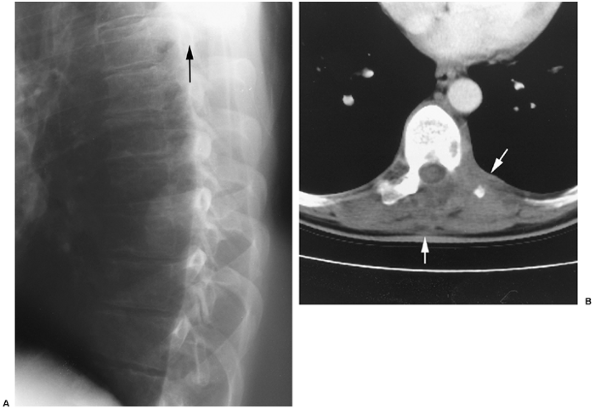 |
Fig. 158-20. Ewing's sarcoma of the thoracic spine. A. Magnified view of a lateral chest radiograph demonstrates a smooth-margined posterior mass (arrow). Although this mass could have been pleural in origin, it is more likely to represent a mediastinal mass. B. Computed tomography confirms the presence of a posterior mediastinal mass (arrows) and demonstrates destruction of the left pedicle and transverse process of the vertebra. This proved to represent a spinal Ewing's sarcoma. |
Pulmonary Hypertension
A diameter of the main pulmonary artery that is greater than the diameter of the adjacent ascending aorta is indicative of pulmonary hypertension. A wide range of disorders can lead to pulmonary hypertension. One useful radiologic schema for evaluating pulmonary hypertension is included in Table 158-2.
Given findings on either the chest radiograph or chest CT, such as pulmonary parenchymal abnormalities or an enlarged heart, it is usually possible to separate the cause of pulmonary hypertension into one of the three general categories of causes of pulmonary hypertension: pulmonary disorders, cardiac disorders, or other disorders. Occasionally, the specific cause (e.g., chronic obstructive pulmonary disease, valvular heart disease, chronic pulmonary emboli) is apparent from findings present on cross-sectional imaging.
Hilar Adenopathy
Any nonenhancing soft tissue in the pulmonary hilum that is greater than 5 mm in diameter is abnormal (see Fig. 158-7). This soft tissue is usually either hilar adenopathy or a central bronchogenic carcinoma. Common causes of hilar adenopathy include lymph node metastasis from bronchogenic carcinoma or extrathoracic malignancies, sarcoidosis, lymphoma, and granulomatous infections such as histoplasmosis, coccidioidomycosis, or primary tuberculosis.
 |
Fig. 158-21. Spinal tuberculosis. A. Posteroanterior chest radiograph demonstrates diffuse widening of the posterior mediastinum. B. T2-weighted axial image of the spine reveals destruction of the vertebral body (black arrows) with a paraspinal fluid collection (white arrows). This was seen at multiple levels of the thoracic and lumbar spine. C. Sagittal T1-weighted image again demonstrates a paraspinal mass (arrows) and shows a sharp-angle scoliosis of the spine with compression of a low thoracic vertebra. Although a diffusely infiltrating tumor might produce this picture, these findings are most suggestive of a chronic infection, in this case spinal tuberculosis. |
Table 158-2. Causes of Pulmonary Hypertension | |
|---|---|
|
P.2393
P.2394
Postoperative Evaluation of the Mediastinum
Unfortunately complications of major thoracic surgery continue to occur despite many advances in surgical technique and preoperative and postoperative medical care. Imaging plays an important role in the evaluation of potential postoperative complications.
Mediastinal complications of thoracic surgery are uncommon in comparison with pulmonary and pleural complications, such as atelectasis, pneumonia, and pleural effusions. Detection of mediastinal collections is the most frequent indication for mediastinal imaging. Chest radiographs are insensitive to the detection of these collections but may suggest the diagnosis if there is progressive enlargement of the mediastinal contours on serial postoperative radiographs. The presence of sternal dehiscence may also be suggested by the presence of a midsternal lucent stripe and sternal wire displacement as emphasized by Boiselle and colleagues (1999), as well as by Boiselle and Mansilla (2002).
Cross-sectional imaging is much more sensitive to the diagnosis of mediastinal collections. These usually appear as nonenhancing fluid attenuation masses interposed between the normal mediastinal structures. Unfortunately, in most instances imaging alone is unable to distinguish between sterile postoperative hematomas and mediastinal abscesses. Therefore, interpretation of mediastinal collections is dependent on correlation with a detailed clinical history.
CT is useful in the evaluation of postoperative complications of esophagectomy. Postoperative fluid collections and anastomotic leaks can be demonstrated by CT (Fig. 158-22). It is important to request administration of oral contrast in all cases in which anastomotic leak is expected.
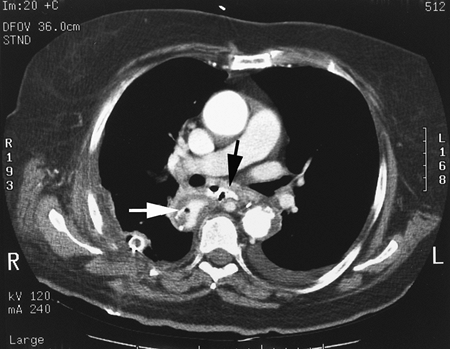 |
Fig. 158-22. Anastomotic leak following esophagectomy. This patient had persistent fevers following esophagectomy and gastric pull-through. Computed tomographic scan after administration of oral and intravenous contrast demonstrates an air and fluid collection (black arrow) outside of the lumen of the intrathoracic stomach (white arrow). There is also a small left pleural effusion. |
Cross-sectional imaging may be used to evaluate for anastomotic aneurysms following tube grafting for aortic aneurysms. MR imaging is useful for determining persistent patency of the false lumen of an aortic dissection, following surgical repair.
Conclusions
Imaging of the mediastinum is an integral part of the clinical evaluation of mediastinal pathology. Chest radiographs are the initial step in the imaging evaluation of the mediastinum but are insensitive to mediastinal diseases and are often nonspecific. Cross-sectional imaging provides increased detail regarding mediastinal abnormalities and often provides a more specific clinical diagnosis. This is best done with CT in the majority of instances, with MR imaging reserved for specific indications.
REFERENCES
Ahn JM, et al: Predicting the histology of anterior mediastinal masses: comparison of chest radiography and CT. J Thorac Imaging 11:265, 1996.
Akwari OE, et al: Dumbbell neurogenic tumors of the mediastinum. Diagnosis and management. Mayo Clin Proc 53:353, 1978.
Aquino SL, et al: Acquired tracheomalacia: detection by expiratory CT scan. J Comput Assist Tomogr 25:394, 2001.
Arita T, et al: Abdominal aortic aneurysm: rupture associated with the high-attenuating crescent sign. Radiology 204:765, 1997.
Baron RL, et al: Computed tomography in the evaluation of mediastinal widening. Radiology 138:107, 1981.
Berkovich G, Levine M, Miller WT Jr: CT findings in patients with esophagitis. AJR 175:1431, 2000.
P.2395
Boiselle PM, Mansilla AV: A closer look at the midsternal stripe sign. AJR 178:945, 2002.
Boiselle PM, Reynolds KF, Ernst A: Multiplanar and three-dimensional imaging of the central airways with multidetector CT. AJR 179:301, 2002.
Boiselle PM, et al: Wandering wires: frequency of sternal wire abnormalities in patients with sternal dehiscence. AJR 173:777, 1999.
Brown LR, et al: Roentgenologic diagnosis of primary corticotropin-producing carcinoid tumors of the mediastinum. Radiology 142:143, 1982.
Castellino RA, et al: Non-Hodgkin lymphoma: contribution of chest CT in the initial staging evaluation. Radiology 191:129, 1996.
Choe YH, et al: MR imaging in the morphologic diagnosis of congenital heart disease. Radiographics 17:403, 1997.
Cigarroa JE, et al: Diagnostic imaging in the evaluation of suspected aortic dissection. N Engl J Med 328:35, 1993.
Creasy JD, et al: Overview of traumatic injury of the thoracic aorta. Radiographics 17:27, 1997.
Doppman JL, et al: Ectopic adrenocorticotropic hormone syndrome: localization studies in 28 patients. Radiology 172:115, 1989.
Dyer DS, et al: Can chest CT be used to exclude aortic injury? Radiology 213:195, 1999.
Ellis K, Austin JHM, Jaretzki A 3rd. Radiologic detection of thymoma in patients with myasthenia gravis. AJR 151: 873, 1988.
Gavant ML, et al: Blunt traumatic aortic rupture: detection with helical CT of the chest. Radiology 197:125, 1995.
Genereux GP, Howie JL: Normal mediastinal lymph node size and number: CT and anatomic study. AJR 142:1095, 1984.
Glazer GM, Axel L, Moss AA: CT diagnosis of mediastinal thyroid. AJR 138:495, 1982.
Halliday KE, Al-Kutoubi A: Draped aorta: CT sign of contained leak of aortic aneurysms. Radiology 199:41, 1996.
Haramati LB, et al: MR imaging and CT of vascular anomalies and connections in patients with congenital heart disease: significance in surgical planning. Radiographics 22:337, 2002.
Hindie E, et al: Primary hyperparathyroidism: higher success rate of first surgery after preoperative Tc-99m sestamibi-I-123 subtraction scanning. Radiology 204:221, 1997.
Ho VB, Prince MR: Thoracic MR aortography: imaging techniques and strategies. Radiographics 18:287, 1998.
Lawler LP, Fishman EK: Multi-detector row CT of thoracic disease with emphasis on 3D volume rendering and CT angiography. Radiographics 21:1257, 2001.
Lee VS, et al: The complementary roles of fast spin-echo MR imaging and double-phase 99mTc-sestamibi scintigraphy for localization of hyperfunctioning parathyroid glands. AJR 167:1555, 1996.
Maerz LL, et al: Role of computed tomographic scans in the staging of esophageal and proximal gastric malignancies. Am J Surg 165:558, 1993.
McKenna RJ Jr, et al: Roentgenographic evaluation of mediastinal nodes for preoperative assessment in lung cancer. Chest 88:206, 1985.
Mirvis SE, et al: Value of chest radiography in excluding traumatic aortic rupture. Radiology 163:487, 1987.
Miyake H, et al: Mediastinal lymphangiomas in adults: CT findings. J Thorac Imaging 11:83, 1996.
Moeller KH, Rosado-de-Christenson ML, Templeton PA: Mediastinal mature teratoma: imaging features. AJR 169:985, 1997.
Moore AV, et al: Age-related changes in the thymus gland: CT-pathologic correlation. AJR 141:241, 1983.
Nakata H, et al: Computed tomography of mediastinal bronchogenic cysts. J Comput Assist Tomogr 6:733, 1982.
Noh HM, et al: CT of the esophagus: spectrum of disease with emphasis on esophageal carcinoma. Radiographics 15:1113, 1995.
Park HM, et al: Efficacy of thyroid scintigraphy in the diagnosis of intrathoracic goiter. AJR 148:527, 1987.
Parker MS, et al: Making the transition: the role of helical CT in the evaluation of potentially acute thoracic aortic injuries. AJR 176:1267, 2001.
Posniak HV, Olson MC, Demos TC: Aortic motion artifact simulating dissection on CT scans: elimination with reconstructive segmented images. AJR 161:557, 1993.
Predey TA, et al: CT of congenital anomalies of the aortic arch. Semin Roentgenol 24:96, 1989.
Ravin CE, Chotas HG: Chest radiography. Radiology 204:593, 1997.
Rebner MGB, et al: CT evaluation of mediastinal masses. Comput Radiol 11:103, 1987.
Rosado-de-Christenson ML, et al: Thymolipoma: analysis of 27 cases. Radiology 193:121, 1994.
Sakai T, et al: Descending thoracic aortic aneurysm: thoracic CT findings after endovascular stent-graft placement. Radiology 212:169, 1999.
Salonen O, et al: Chest radiography and computed tomography in the evaluation of mediastinal adenopathy in lymphoma. Acta Radiol 28:747, 1987.
Sebastia C, et al: Aortic dissection: diagnosis and follow-up with helical CT. Radiographics 19:45, 1999.
Selvaraj A, Wood AJ: Superior mediastinal chordoma presenting as a bilobed paravertebral mass. Eur J Cardiothorac Surg 23:248, 2003.
Shields TW, Immerman SC: Mediastinal parathyroid cysts revisited. Ann Thorac Surg 67:581, 1999.
Shimoyama K, et al: Pulmonary hilar lymph node metastases from lung cancer: evaluation based on morphology at thin-section, incremental, dynamic CT. Radiology 203:187, 1997.
Siegel CL, et al: Abdominal aortic aneurysm morphology: CT features in patients with ruptured and nonruptured aneurysms. AJR 163:1123, 1994.
Sommer T, et al: Aortic dissection: a comparative study of diagnosis with spiral CT, multiplanar transesophageal echocardiography, and MR imaging. Radiology 199:347, 1996.
Thomas F, et al: Thoracic CT-scanning follow-up of residual mediastinal masses after treatment of Hodgkin's disease. Radiother Oncol 11:119, 1988.
Verstandig AG, et al: Thymoma report of 71 cases and a review. Crit Rev Diag Imaging 33:201, 1992.
von Schulthess GK, et al: Mediastinal masses: MR imaging. Radiology 158:289, 1986.
Webb EM, Elicker BM, Webb WR: Using CT to diagnose nonneoplastic tracheal abnormalities: appearance of the tracheal wall. AJR 174:1315, 2000.
Weinstein JB, Aronberg DJ, Sagel SS: CT of fibrosing mediastinitis: findings and their utility. AJR 141:247, 1983.
White CS, Templeton PA, Attar S: Esophageal perforation: CT findings. AJR 160:767, 1993.
Whittlesey D: Prospective computed tomographic scanning in the staging of bronchogenic cancer. J Thorac Cardiovasc Surg 95:876, 1988.
EAN: 2147483647
Pages: 203